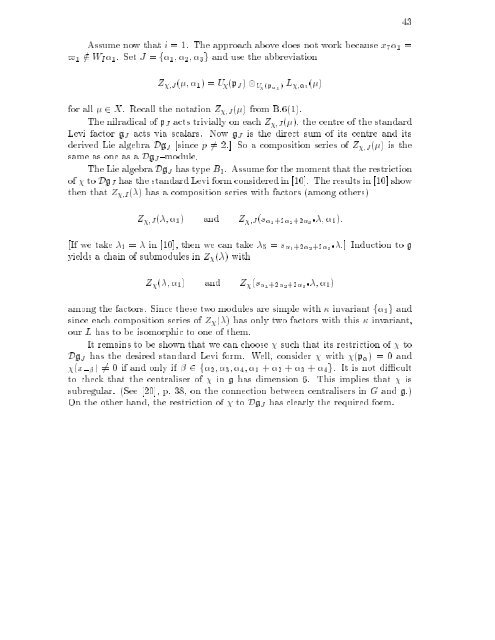subregular nilpotent representations of lie algebras in prime ...
subregular nilpotent representations of lie algebras in prime ...
subregular nilpotent representations of lie algebras in prime ...
Create successful ePaper yourself
Turn your PDF publications into a flip-book with our unique Google optimized e-Paper software.
Assume now that i = 1. The approach above does not work because x7 1 =<br />
$1 =2 WI 1. Set J = f 1; 2; 3g and use the abbreviation<br />
Z ;J( ; 1) =U (pJ ) U (p 1 ) L ; 1( )<br />
for all 2 X. Recall the notation Z ;J( ) from B.6(1).<br />
The nilradical <strong>of</strong> pJ acts trivially on each Z ;J( ), the centre <strong>of</strong> the standard<br />
Levi factor gJ acts via scalars. Now gJ is the direct sum <strong>of</strong> its centre and its<br />
derived Lie algebra DgJ [s<strong>in</strong>ce p 6= 2.] So a composition series <strong>of</strong> Z ;J( ) is the<br />
same as one as a DgJ {module.<br />
The Lie algebra DgJ has type B3. Assume for the moment that the restriction<br />
<strong>of</strong> to DgJ has the standard Levi form considered <strong>in</strong> [10]. The results <strong>in</strong> [10] show<br />
then that Z ;I( ) has a composition series with factors (among others)<br />
Z ;J( ; 1) and Z ;J(s 1+2 2+2 3 ; 1):<br />
[If we take 1 = <strong>in</strong> [10], then we can take 5 = s 1+2 2+2 3 .] Induction to g<br />
yields a cha<strong>in</strong> <strong>of</strong> submodules <strong>in</strong> Z ( ) with<br />
Z ( ; 1) and Z (s 1+2 2+2 3 ; 1)<br />
among the factors. S<strong>in</strong>ce these two modules are simple with <strong>in</strong>variant f 1g and<br />
s<strong>in</strong>ce each composition series <strong>of</strong> Z ( ) has only two factors with this <strong>in</strong>variant,<br />
our L has to be isomorphic to one <strong>of</strong> them.<br />
It rema<strong>in</strong>s to be shown that we can choose such that its restriction <strong>of</strong> to<br />
DgJ has the desired standard Levi form. Well, consider with (p )=0and<br />
(x, ) 6= 0 if and only if 2f 2; 3; 4; 1 + 2 + 3 + 4g. It is not di cult<br />
to check that the centraliser <strong>of</strong> <strong>in</strong> g has dimension 6. This imp<strong>lie</strong>s that is<br />
<strong>subregular</strong>. (See [20], p. 38, on the connection between centralisers <strong>in</strong> G and g.)<br />
On the other hand, the restriction <strong>of</strong> to DgJ has clearly the required form.<br />
43

















